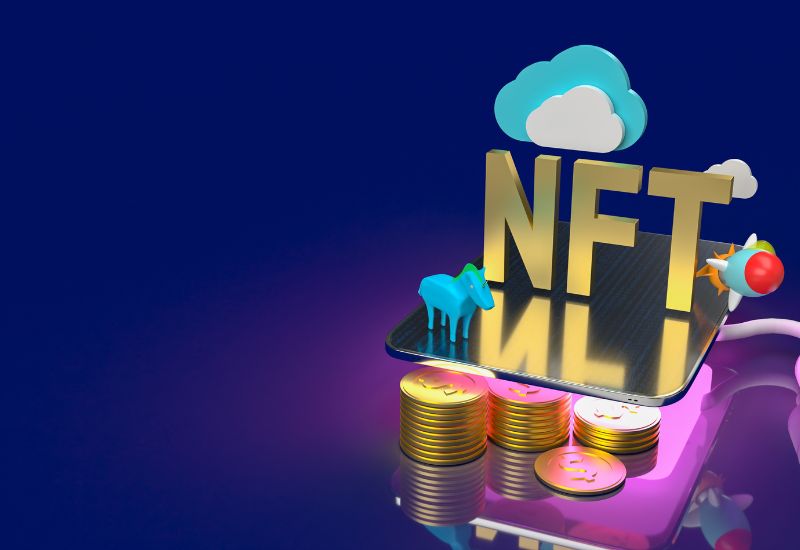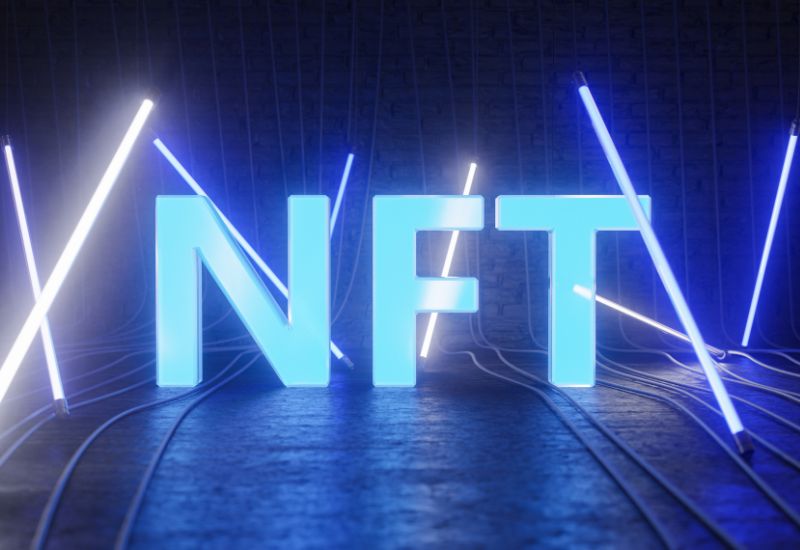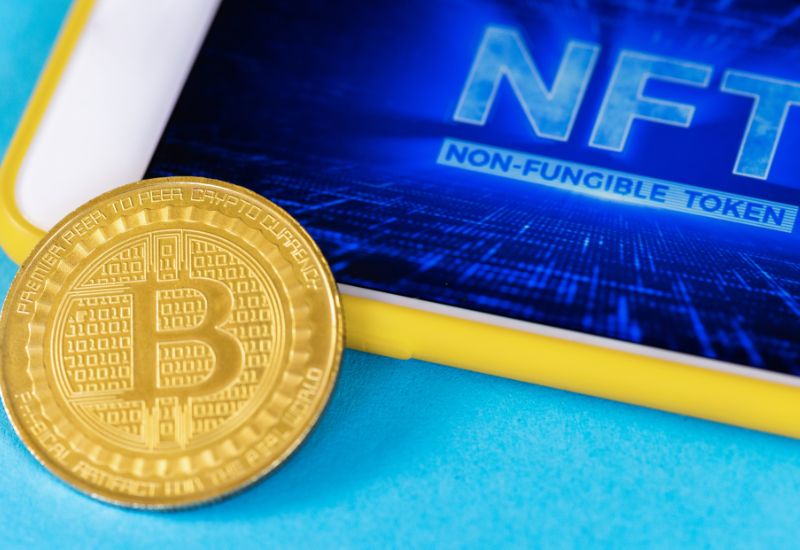Welcome to the exciting world of non-fungible tokens (NFTs), where digital art and collectibles are taking the marketplace by storm. As a journalist, it is my duty to guide you through the fascinating world of NFTs and explain why they are making headlines in the world of finance, art, and entertainment.
NFTs are unique digital assets that are stored on a blockchain, similar to cryptocurrency. However, unlike Bitcoin and other cryptocurrencies, NFTs are not interchangeable. Each NFT is one-of-a-kind and cannot be replicated, making them highly valuable to collectors and investors alike.
The world of NFTs has exploded in popularity over the past few years, with record-breaking sales of digital art, music, and even tweets. In March 2021, an NFT by digital artist Beeple sold for a staggering $69 million at Christie’s auction house, making it the third-highest sale for a living artist.
But what makes NFTs so powerful in the marketplace? One reason is their ability to provide proof of ownership and authenticity for digital assets that were previously difficult to verify. With NFTs, creators can prove that their artwork or collectible is the original, and buyers can trust that they are purchasing a unique, one-of-a-kind asset.
Another reason for NFTs’ power is their ability to create new revenue streams for creators. In the past, digital artists and musicians struggled to monetize their work, as it was often shared and copied without permission. With NFTs, creators can sell their work as a one-of-a-kind asset, generating income from each sale.
But NFTs are not without their controversies. Some critics argue that NFTs contribute to the carbon footprint of blockchain technology, and that the hype surrounding NFTs is driving up the prices of digital assets to unsustainable levels.
As we explore the world of NFTs in this comprehensive guide, we will examine the pros and cons of this exciting new marketplace. We will look at the most significant NFT sales, the impact of NFTs on the art and music industries, and the potential future of NFTs in finance and gaming.
So fasten your seatbelt and get ready to dive into the world of NFTs. Whether you are an artist, collector, investor, or simply curious about this emerging technology, this guide will provide you with everything you need to know about the power of NFTs in the marketplace.
See also: Explore the NFT Marketplace: Buy, Sell, and Trade Non-Fungible Tokens
Pros and cons of NFTs
NFTs, or non-fungible tokens, have been making waves in the world of digital art and collectibles. These unique digital assets have become a hot topic, with some praising their potential to revolutionize the art market, while others remain skeptical. As with any new technology, NFTs come with their own set of pros and cons. Let’s explore both sides of the debate to give you a comprehensive understanding of NFTs.
Pros
Unique and irreplaceable
NFTs are unique digital assets that are one of a kind. They cannot be replicated or duplicated, making them truly irreplaceable. This characteristic makes them highly desirable to collectors and art enthusiasts who value rarity and exclusivity.
Monetization of digital art
NFTs have opened up a new market for digital art, allowing artists to monetize their work and receive royalties for their creations. This provides a new revenue stream for artists and can help them earn a living from their passion.
Ownership and provenance
NFTs provide a secure and transparent way of tracking ownership and provenance of digital assets. This is particularly important for artists who want to protect their work from unauthorized use and ensure that they receive proper credit and compensation for their creations.
Increased accessibility
NFTs have made it easier for people to access and own unique digital assets. This has democratized the art world, making it more inclusive and accessible to a wider range of people.
Cons
Environmental impact
NFTs are created using blockchain technology, which requires a significant amount of energy. This has raised concerns about their environmental impact, as the production of NFTs contributes to the carbon footprint of the art industry.
Lack of regulation
NFTs are a new and largely unregulated market, which has led to some concerns about fraud and scams. There have been cases of people selling fake NFTs or using other people’s work without their permission.
Exclusivity and elitism
Some critics argue that NFTs reinforce the exclusivity and elitism of the art world, as they cater to a wealthy and privileged audience. This can create a divide between those who can afford to buy NFTs and those who cannot.
Uncertain future
The future of NFTs is still uncertain, and there are questions about whether they will remain a viable market or if they are just a passing trend. As with any new technology, there is always the risk of obsolescence or being replaced by newer and better alternatives.
NFTs have the potential to revolutionize the art world, providing artists with a new way to monetize their work and collectors with a new way to own and display digital assets. However, they also come with their own set of challenges, including environmental concerns, lack of regulation, and questions about their long-term viability. As with any investment, it is important to weigh the pros and cons carefully and make informed decisions based on your own personal values and goals.

NFTs in the Music Industry: How Musicians Are Using Them to Their Advantage
In an industry that has been largely dominated by streaming platforms, musicians have found a new way to monetize their work and connect with their fans: non-fungible tokens (NFTs). These digital collectibles, bought and sold using cryptocurrency, have been revolutionizing the music industry, providing artists with a new revenue stream and giving them the ability to create unique experiences for their fans.
One of the most significant advantages of NFTs is that they allow musicians to earn money directly from their fans. With NFTs, artists can sell unique digital assets, such as songs or live events, and earn a percentage of the profits each time they are sold on the secondary market. This provides a new source of income for musicians and allows them to bypass traditional music industry gatekeepers.
Additionally, NFTs have the potential to change the way music is consumed and experienced. By creating unique digital assets, artists can offer their fans exclusive experiences and collectibles that cannot be replicated. For example, an artist could sell an NFT that includes a private performance or a virtual meet and greet with the artist. This provides fans with a new way to connect with their favorite musicians and creates a sense of exclusivity and rarity that cannot be achieved with traditional streaming platforms.
Despite the potential benefits of NFTs, there are still challenges and concerns surrounding their use in the music industry. One of the main concerns is the environmental impact of NFTs, as the process of creating and selling them requires a significant amount of energy. However, there are efforts underway to create more sustainable methods for creating and selling NFTs, such as using renewable energy sources.
Another challenge is the potential for scams and fraud in the NFT market. Because NFTs are a relatively new technology, there are still many unknowns and risks associated with them. However, there are measures that musicians and fans can take to protect themselves, such as working with reputable NFT platforms and conducting thorough research before buying or selling NFTs.
Despite these challenges, many musicians and industry experts believe that NFTs have the potential to transform the music industry and provide new opportunities for artists and fans alike. In fact, some have even suggested that NFTs could be the future of music.
As the music industry continues to evolve and adapt to new technologies, it is clear that NFTs will play an increasingly important role in the years to come. With their ability to create unique experiences and revenue streams for musicians, NFTs are poised to become a game-changer for the music industry. Whether you are a musician, a fan, or simply an observer of the industry, it is clear that NFTs are a trend to watch in the years ahead.
NFTs in finance and Gaming: Unlocking New Revenue Streams
Non-Fungible Tokens (NFTs) have taken the world by storm. From art to music, NFTs are making headlines as a new way of buying and selling digital content. However, it’s not just the art and music world that’s benefiting from NFTs. Finance and gaming are two industries that are also unlocking new revenue streams with the help of NFTs.
NFTs are digital assets that represent ownership of a unique piece of content, such as an image, video, or music file. They are stored on a blockchain, which is a decentralized digital ledger that provides security and transparency. Because each NFT is unique and cannot be replicated, it’s a powerful tool for proving ownership and authenticity.
In finance, NFTs are being used to represent ownership of real-world assets such as real estate, stocks, and even luxury goods. For example, a company might issue an NFT that represents ownership of a piece of real estate. The NFT would be sold to investors who would then have a stake in the property. This makes it easier for investors to buy and sell assets without having to go through the traditional channels.

In gaming, NFTs are being used to represent ownership of in-game assets such as weapons, skins, and virtual real estate. This creates a new revenue stream for game developers, who can sell NFTs to players who want to own a piece of the game. NFTs also give players a new way to monetize their gaming skills. For example, a player who has earned a rare in-game item could sell it as an NFT to other players.
NFTs are also being used to create new revenue streams for content creators. Musicians, artists, and writers can sell NFTs that represent ownership of their work. This gives them a new way to monetize their content and reach a wider audience.
Despite the potential benefits of NFTs, there are also concerns about their impact on the environment. Because NFTs are stored on a blockchain, they require a lot of energy to create and maintain. This has led some critics to question whether the benefits of NFTs are worth the environmental cost.
Overall, NFTs are a powerful tool for unlocking new revenue streams in finance and gaming. While there are concerns about their impact on the environment, there’s no denying the potential benefits of this new technology. As more industries explore the possibilities of NFTs, it will be interesting to see how they continue to evolve and shape the digital landscape.
See also: Navigating the NFT Marketplace: A Comprehensive List
NFTs and Sports: A New Era of Fan Engagement
In the world of sports, fan engagement has always been a top priority for teams and organizations. From season tickets to merchandise, sports teams have always tried to find new and innovative ways to connect with their fans. However, with the rise of non-fungible tokens (NFTs), a new era of fan engagement has emerged.
NFTs are unique digital assets that use blockchain technology to verify ownership and authenticity. In the sports world, NFTs can be used for a variety of purposes, from collectibles to virtual access tokens. And as the popularity of NFTs continues to grow, sports teams and organizations are starting to realize the potential they hold for fan engagement.
One of the most popular uses of NFTs in sports is for collectibles. NFTs allow sports teams to create unique and rare digital assets that fans can collect and trade. These collectibles can take the form of anything from player cards to game highlights, and can be sold through online marketplaces or directly by the teams themselves.
But NFTs can be more than just collectibles. They can also be used to provide fans with exclusive access to events and experiences. For example, some sports teams have used NFTs as virtual access tokens that grant fans access to special events, like meet-and-greets with players or VIP seats at games.
Another way that NFTs are being used in sports is to create digital season ticket memberships. Instead of receiving physical tickets in the mail, fans can now purchase digital season tickets that are tied to an NFT. This not only provides a more convenient way for fans to attend games, but also creates a new collectible for fans to add to their collections.

But as with any new technology, there are concerns about the environmental impact of NFTs. NFTs are created using blockchain technology, which requires a significant amount of energy. However, there are ways to create more sustainable NFTs, such as using proof-of-stake instead of proof-of-work blockchain algorithms.
Despite these concerns, it’s clear that NFTs are quickly becoming a major player in the world of sports fan engagement. From collectibles to virtual access tokens, NFTs offer a new way for fans to connect with their favorite teams and players. And as the technology continues to evolve, it’s likely that we’ll see even more innovative uses for NFTs in the world of sports.
NFTs represent a new era of fan engagement in sports. While there are still concerns about their environmental impact, the potential for NFTs to provide fans with unique and exclusive experiences is undeniable. As sports teams and organizations continue to explore the possibilities of NFTs, it’s clear that this technology is here to stay. So whether you’re a die-hard sports fan or just curious about the future of fan engagement, NFTs are definitely worth keeping an eye on.
The Future of NFTs: Trends and Predictions
As the digital world continues to evolve, so do the ways in which we create and consume content. One of the most fascinating developments in recent years has been the rise of non-fungible tokens, or NFTs, which have opened up entirely new possibilities for creators and collectors alike.
So, what are NFTs, and what does the future hold for this emerging market? Let’s take a closer look at some of the key trends and predictions.
First and foremost, it’s worth understanding exactly what NFTs are. Essentially, an NFT is a unique digital asset that is stored on a blockchain, meaning that it cannot be duplicated or replicated. This creates a sense of scarcity and exclusivity that is unprecedented in the digital world.
NFTs can take many forms, from art and music to video games and collectibles. The key is that each NFT is completely unique and irreplaceable, making it a valuable asset for collectors and enthusiasts.
One of the most exciting trends in the world of NFTs is the way in which they are being used to create entirely new forms of media and entertainment. Virtual reality and immersive experiences are becoming increasingly popular, and NFTs offer a way to create truly one-of-a-kind experiences that cannot be replicated elsewhere.
For example, imagine a virtual reality art exhibit in which each piece is an NFT. Collectors could purchase a ticket to the exhibit and have exclusive access to each piece, creating a sense of exclusivity and value that is simply not possible in a traditional art exhibit.
Another trend to watch in the world of NFTs is the way in which they are being used to create entirely new business models. For example, some creators are using NFTs as a way to crowdfund their projects, selling limited-edition NFTs to raise money for development costs.
Similarly, some musicians are using NFTs as a way to release exclusive content to their most dedicated fans. By releasing a limited-edition NFT that includes access to an exclusive concert or recording, musicians can create a new revenue stream while also rewarding their most loyal supporters.
Of course, as with any emerging market, there are risks involved with NFTs as well. One of the biggest concerns is the potential for fraud or scams, as the market is still largely unregulated and there are few safeguards in place to protect investors.
However, many experts believe that these risks can be mitigated with proper education and regulation. As the market for NFTs continues to grow and mature, we can expect to see more safeguards put in place to protect investors and consumers alike.
Overall, the future of NFTs is bright and full of possibilities. From creating entirely new forms of media and entertainment to revolutionizing traditional business models, NFTs offer a new way of thinking about digital assets and their value. As we continue to explore the potential of this emerging market, we can expect to see even more exciting developments and innovations in the years to come. So, whether you’re a creator, a collector, or simply someone interested in the cutting edge of digital culture, now is the time to start paying attention to NFTs and all that they have to offer.
See also: From Memes to Masterpieces: The Best NFT Marketplace for Creative Content

